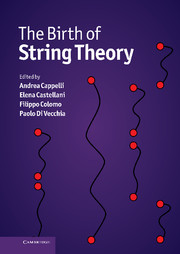Book contents
- Frontmatter
- Contents
- List of contributors
- Photographs of contributors
- Preface
- Abbreviations and acronyms
- Part I Overview
- EARLY STRING THEORY
- Part II The prehistory: the analytic S-matrix
- Part III The Dual Resonance Model
- Part IV The string
- TOWARDS MODERN STRING THEORY
- Part V Beyond the bosonic string
- Part VI The superstring
- 35 Introduction to Part VI
- 36 Supersymmetry in string theory
- 37 Gravity from strings: personal reminiscences of early developments
- 38 From the Nambu–Goto to the σ-model action
- 39 Locally supersymmetric action for the superstring
- 40 Personal recollections
- 41 The scientific contributions of Joël Scherk
- Part VII Preparing the string renaissance
- Appendix A Theoretical tools of the Sixties
- Appendix B The Veneziano amplitude
- Appendix C From the string action to the Dual Resonance Model
- Appendix D World-sheet and target-space supersymmetry
- Appendix E The field theory limit
- Index
37 - Gravity from strings: personal reminiscences of early developments
from Part VI - The superstring
Published online by Cambridge University Press: 05 May 2012
- Frontmatter
- Contents
- List of contributors
- Photographs of contributors
- Preface
- Abbreviations and acronyms
- Part I Overview
- EARLY STRING THEORY
- Part II The prehistory: the analytic S-matrix
- Part III The Dual Resonance Model
- Part IV The string
- TOWARDS MODERN STRING THEORY
- Part V Beyond the bosonic string
- Part VI The superstring
- 35 Introduction to Part VI
- 36 Supersymmetry in string theory
- 37 Gravity from strings: personal reminiscences of early developments
- 38 From the Nambu–Goto to the σ-model action
- 39 Locally supersymmetric action for the superstring
- 40 Personal recollections
- 41 The scientific contributions of Joël Scherk
- Part VII Preparing the string renaissance
- Appendix A Theoretical tools of the Sixties
- Appendix B The Veneziano amplitude
- Appendix C From the string action to the Dual Resonance Model
- Appendix D World-sheet and target-space supersymmetry
- Appendix E The field theory limit
- Index
Summary
Abstract
I discuss the early developments of string theory with respect to its connection with gauge theory and general relativity from my own perspective. The period covered is mainly from 1969 to 1974, during which I became involved in research on dual string models as a graduate student. My thinking towards the recognition of string theory as an extended quantum theory of gravity is described. Some retrospective remarks on my later works related to this subject are also given.
Prologue: an encounter with the dual string model
I entered graduate school at Hokkaido University, Sapporo, in April 1969.Myadvisor, Akira Kanazawa, who was an expert in the dispersion theoretic approach to strong interactions, proposed to have a series of seminars on Regge pole theory. However, the Regge pole theory was somewhat disappointing for me. I felt that it was too formal and phenomenological in its nature. Looking for some more favourable topics, I began studying the quantum field theory of composite particles, which, I thought, might be useful to explain the Regge behaviour from the dynamics of fundamental particles. I read many papers related to this problem, such as those on compositeness criteria, on the definition of the asymptotic field for a composite particle, the Bethe–Salpeter equation, and so on. Although I felt that these subjects themselves were not yet what I really wanted to pursue, I enjoyed learning various different facets of quantum field theory.
- Type
- Chapter
- Information
- The Birth of String Theory , pp. 459 - 473Publisher: Cambridge University PressPrint publication year: 2012
- 1
- Cited by



